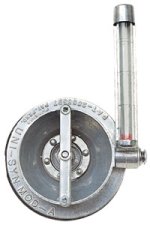Got both motors checked by mechanic when I bought the boat and both motors passed. Ran it out once and the starboard motor wouldn't start. Limped home, changed filter, plugs and wires and it fired right up. Took it out again and now it won't run for more than a minute. Took it back to the mechanic to have the carbs rebuilt. He checked it over again and found that it wasn't firing on all four. Said the power pack was bad. Replaced power pack. He rebuilt the carbs and was about to tune them when the motor wouldn't run on its own. All of the sudden, it's not making power on one side so the stator was bad. Replaced the stator. Now we have fire to all four and good voltage. Ignition timing was re-set and even when its running ragged, the timing is still good. Discovered that the fule pump was passing fuel through the pulsating side. Removed and disassembled the pump and found the diaphragm was torn and dry rotted. Rebuilt the fuel pump, reinstalled it and still had the same problem. Replaced the fuel pump. This is a VRO pump with the oil side plugged with a bolt. Running mixed gas through a new Racor. Other motor runs just fine on the same fuel. Not bad gas. Engine still sputtering and backfiring at idle. Pulled the manifold and inspected the reed boxes. No light coming through, so they were cleaned and re-installed. Pulled the flywheel off to see if the shear pin had failed. Nope. Still coughing, racing and backfiring. Choked off each carburetor one at a time and 3 of the four will kill it when choked, one has no affect. We did this a couple of times and the carb with no affect jumps around. In other words, it's not the same carb. There is an intake air leak somewhere. The mechanic wants to pull the power head off and check the crank case seal next. I'm already in it for considerable maintenance hours and this proposed job is going to take another 5-6 hours, just to trouble shoot. It may or may not be the solution to the problem. What else could it possibly be??? I'm looking to hear from former OMC tech-reps or someone else who has had this same thing happen and what was done to fix it. My mechanic has been working on OMC's for 35 years, has been to all of the schools and comes highly recommended locally as "THE" guy. However, this problem has him ripping his hair out and emptying my wallet! I would love to hear that this is something simple staring us right in the face, or that changing the crankcase seal IS the right fix. I'll go through with it if I know in advance that this procedure should work. But if it's just another "check and see" then I'm not so sure I want to mess with the expense. The motors have pretty low time for their age and are both making 125 psi on all cylinders with no leak down. The lower units are fresh and I have no reason to believe that they won't last a long time once this is fixed. I'd hate to have to replace them over something that maybe a simple matter of a seal. Please, HELP!
Home
Outboard Motor Parts
Chrysler outboard parts Evinrude outboard parts Force outboard parts Honda outboard parts Johnson outboard parts Mariner outboard parts Mercury outboard parts Suzuki outboard parts Tohatsu outboard parts Yamaha outboard partsInboard & Sterndrive Engine Parts
Chrysler Marine inboard parts Crusader Marine parts MerCruiser sterndrive parts OMC sterndrive parts Pleasurecraft Marine parts Volvo Penta marine parts + MoreAll Engine Brands
All Manuals HomeOutboard Repair Manuals
Chrysler outboard manuals Evinrude outboard manuals Force outboard manuals Honda outboard manuals Johnson outboard manuals Mariner outboard manualsMercury outboard manuals Nissan outboard manuals Suzuki outboard manuals Tohatsu outboard manuals Yamaha outboard manuals
Inboard & Sterndrive Engine Manuals
MerCruiser sterndrive manuals OMC sterndrive manuals Volvo Penta marine engine manualsPlease Note
MarineEngine.com does not offer troubleshooting assistance or repair advice by email or by telephone.
You are invited to join our public Boat Repair Forum to seek assistance from other members.
You may also visit the Boat Motor Manuals section of our site to obtain a service manual.


